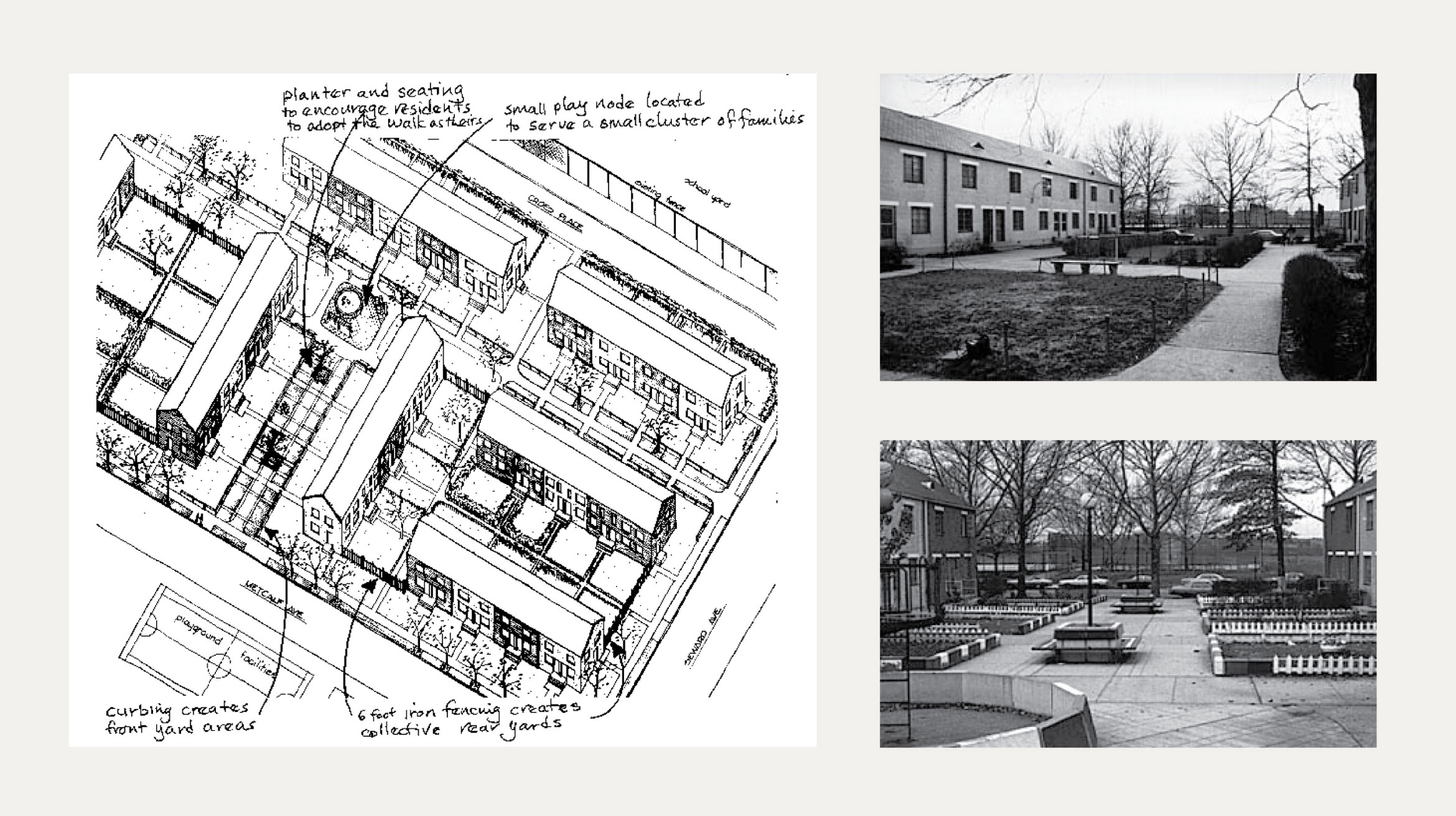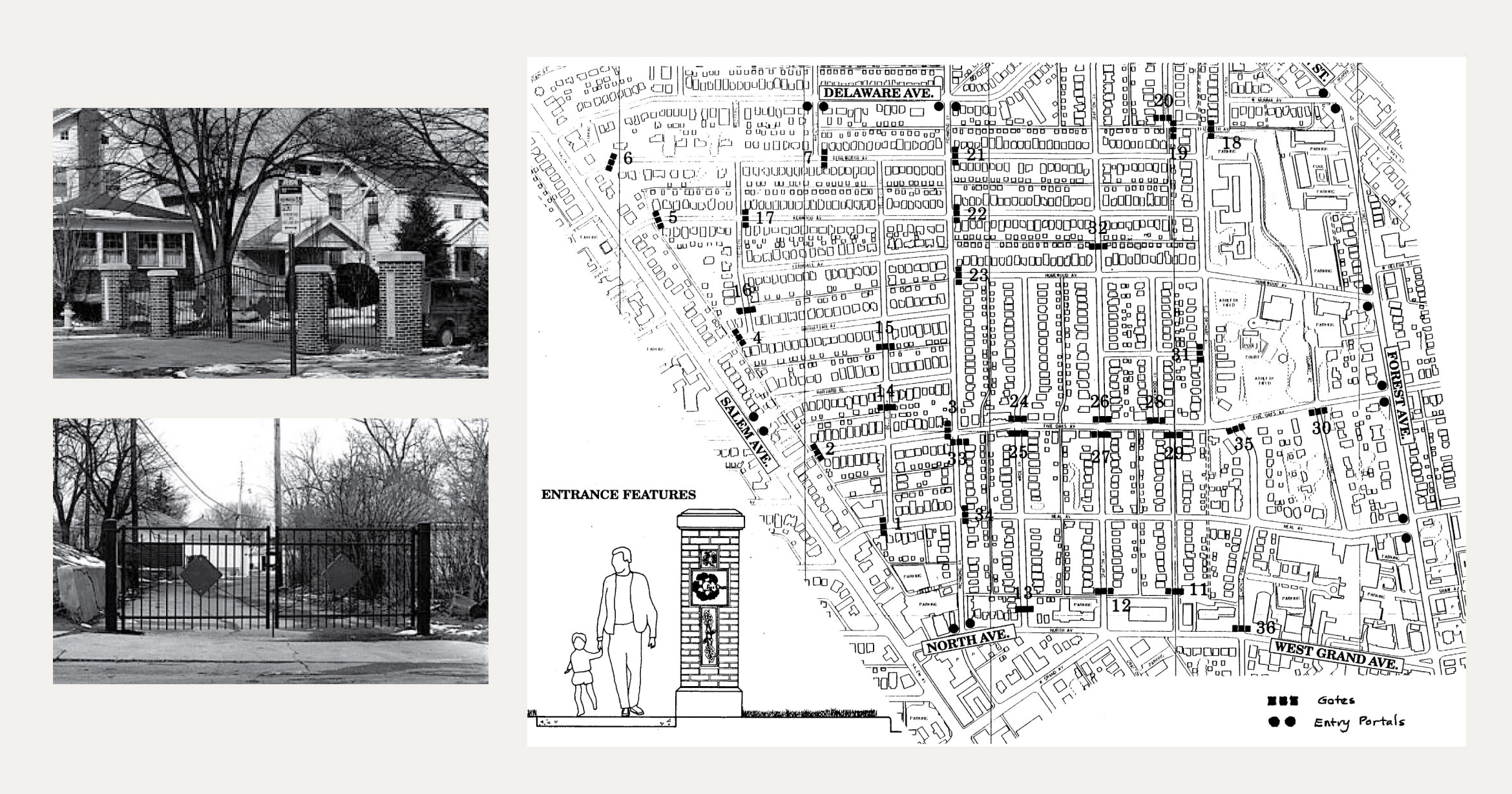The Location of Justice
An examination of the pervasive and often overlooked infrastructure of criminal justice in New York and the spaces that could serve a more just city.
In This SeriesWe are celebrating 15 years — and counting — of stories that are deeply researched and deeply felt, that build a historical record of what the city has been.
Can design keep you safe from crime? Architects and urbanists have been making that claim since urban crime — or the threat of it — reached crisis proportions in the 1960s. Jane Jacobs argued that eyes on the street kept malfeasants in check. Oscar Newman surveyed high-rise housing and claimed that building form created and precluded opportunities for crime. Since then, generations of practitioners of Crime Prevention Through Environmental Design have touted the efficacy of bollards, gates, and cameras in deterring violent acts. But with scant evidence to support those claims, at what cost do we build “defensible space”? Architectural historian Joy Knoblauch looks back at sixty years of attempts to secure space and asks whether safety lies in the design of the built environment, in our social structures, or in our heads.
It seems like common sense: a well-designed environment could deter crime. Spaces that keep interlopers out, encourage upkeep, and reward vigilance might make bad behavior harder and less likely. Since the middle of the last century, some architects and criminologists (scholars who seek to explain causes of criminal behavior using scientific methods) have elevated a common-sense notion to the level of scientific fact, and recast design as a crime-prevention strategy. Indeed, social scientific tools can help clarify the relationship between behavior and the built environment — but done poorly, social science can also obscure the social complexity, basic human irrationality, and powerful social fictions that trouble common-sense ideas about how design regulates crime. For more than forty years, proponents of Crime Prevention Through Environmental Design (CPTED) have employed design as a means to deter crimes from vandalism to murder, yet it has been rhetoric, not scientific evidence, that has supported such strategies.
The idea of preventing crime through the design of the urban environment entered the mainstream with Jane Jacobs, who believed design could both reduce real crime and create a mood of greater security in the city. In Jacobs’s view, laid out in 1961 in Death and Life of Great American Cities, urban design could promote social connection and deter transgression by literally placing people closer together with clear sight lines.[1] To Jacobs, fear was as inevitable among city-dwellers as the strangers they would encounter on city streets, but this fear could be calmed by the feeling that other residents were keeping watch. She famously proposed that low-rise, mixed-use neighborhoods with eyes on the street would enable residents to police their own neighborhood. Self-policing enabled by design could improve the urban mood and the actual rate of crime, in Jacobs’s framework, because the real and rhetorical fear of crime were closely related. Jacobs believed that good forms could build a good society — a central tenet of the modernist architecture of which she was otherwise skeptical. If a good city looks one way and the bad city another way, modernists implied, the arrow of causality could also be reversed. Not only might a good citizenry build a healthy city, but a healthy city might make people behave better. Jacobs agreed.
Over the course of the 1960s, the problem of crime in the United States gained political significance and popular attention. New methods of reporting crimes and gathering data coincided with a growing juvenile population and the concentration of urban poverty, as well as dramatic urban protests in the second half of the decade. All combined into general anxiety about troubled cities, stoked by national media and politicians. It was in this climate that the concept of “Crime Prevention Through Environmental Design,” known as CPTED, came into popular use. After high-profile violent events such as the 1964 murder of Kitty Genovese, the media portrayed neighbors as less innately helpful than Jacobs had claimed. Social psychologists sought an understanding of when and how people intervene and defend others. Genovese’s murder in the safety of her Queens neighborhood, allegedly watched and uninterrupted by 38 of her neighbors, was explained as a result of the anonymity created by high rise housing.[2] Eyes on the street were not enough. Instead, in 1968 John M. Darley and Bibb Latane proposed one of the most enduring findings of social psychology, known as the “bystander effect”: a single person is likely to intervene, but in a group the same individual is unsure of responsibility and will do nothing.[3] This theory grounded Oscar Newman’s 1972 book Defensible Space, Crime Prevention Through Urban Design. In his popular book and related articles, the architect suggested that design should trigger an allegedly natural human territoriality. If the urban environment could be carved into territories, each neighbor would know which “turf” he or she must defend.
Newman proposed a theory of housing design that centered on three principles: territoriality, surveillance, and image. According to Newman and his collaborator, psychologist George Rand, territoriality especially was sorely missing in modern housing projects. Large undifferentiated grounds had created community but now discouraged the necessary “decision to act,” because “proprietary rights” to the area had not been honored. Newman claimed to show how dividing space could reduce crime, referencing an experiment in which a chain link fence at was installed at Pruitt Igoe in St. Louis and gate keys granted only to the residents who lived in the building. Clearly, the experiment did not reduce crime sufficiently; the housing project was demolished, to great fanfare, just as Newman’s book was published. Newman’s true contribution was to latch on to a very powerful rhetorical idea: that buildings can reinforce a tendency to private property.
Newman’s second principle, “natural surveillance,” resembled Jane Jacobs’s model of “eyes on the street.” But unlike Jacobs, Newman considered surveillance supplementary to territoriality, not a solution in and of itself. Newman agreed with arguments by Jacobs and other housing experts like Elizabeth Wood that regular monitoring of proprietary grounds would be essential to help residents determine when behavior was normal, and when to intervene. He focused in particular on what he called “visually deprived semipublic interiors” such as hallways near elevators, determining that windows should be aimed at the exterior courtyards so that entering residents could see who was there waiting. He also wrote about grounds where “winding access paths provide many opportunities for muggers to conceal themselves while awaiting arrival of a victim.” Calling out the shrubbery at the corners of such paths in particular, Newman portrayed the urban landscape as a place of danger, where any perceived opportunity for crime would necessarily be seized. Despite the persistent lack of evidence that such designs can increase the crime rate, or even that criminals act rationally, these just-so narratives took root.
Newman’s third principle, while more amorphous, may paradoxically be the most valid. He argued that the image of a housing project is key. Although construction by housing authorities was often very well done, at a price per square foot comparable to luxury high rises, the design, driven by an imperative to make public housing appear frugal, led to the area being stigmatized, and the residents subsequently victimized by criminals. He further worried about a growing trend to harden such environments, bemoaning, for instance, clear plastic covers over lighting fixtures of the “mercury vapor type that casts a strong, purplish light.” By rejecting aesthetics associated with poverty and avoiding a hardened, unmaintained appearance, he argued, an environment would function to deter crime. Newman may have been wrong that such design choices could reduce real crime, but he may have been right that design’s most significant power could be to create an image and a mood of security.
Social scientists draw a fine distinction between different kinds of fear.[4] If someone is afraid of being victimized, he or she can be said to have a “concrete” fear of crime. A concrete fear of crime may be founded in individuals’ own experiences or those of people with whom they identify. It is more common among members of demographic groups who are frequently victims of crime — like older people, women, racial minorities, and the poor. By contrast, someone who feels an “abstract” fear of crime has a general sense that crime is a problem in society. This abstract fear seems to correlate more with education and media exposure than with the statistical likelihood of becoming a victim. Anxiety about crime may be eased or exacerbated by environment, but it would seem that environment has little effect on a concrete fear of crime — or, for that matter, on the real crime rate.
Newman’s principles confused concrete and abstract fears of crime with real crime — which makes sense given the methods he employed. A seasoned propagandist, Jacobs compelled readers’ emotions and imaginations, but Newman appealed to his audience’s intuition with a veneer of social science. With his collaborators, Newman made graphs of New York City Housing Authority police force data, newly recorded and available on computer tape, to show a direct relationship between building height and crime.[5] Experts have since argued that given differences in demographics of the residents, the buildings he selected were not comparable — a high rise populated by senior citizens cannot be compared with one with a high proportion of adolescents. But the public at the time was less concerned with the nuances of data; the association between high-rise public housing and crime has endured to this day.
In architecture, the trend away from high-rise public housing in favor of low-rise high-density housing through the 1970s and 1980s can largely be attributed to Newman’s theories of territory, which spread through his personal and professional contacts. Those theories appealed to the young designers who worked on Marcus Garvey Village in Brooklyn, a project celebrated as cutting edge when the Museum of Modern Art featured it in the 1973 exhibition “Another Chance for Housing: Low-Rise Alternatives.” An article framed the low-rise enterprise as a burgeoning alternative to more typical imitations of Le Corbusier’s towers in the park — and invoked Oscar Newman to legitimate it, claiming that he had shown there to be “a direct relationship between the height of public housing buildings and the amount of crime and vandalism they engender.”[6] By contrast, this low-rise development would balance “community” with a sense of “propriety” by limiting the number of residents in a single entry, who would recognize who belonged there.
Newman also counted crime policymakers among his early adherents. In 1975, he followed up his first book with a set of principles, budgets, and recommendations for door hardware vetted by the New Jersey Housing Finance Agency, the National Institute of Law Enforcement and Criminal Justice, the Indianapolis Housing Authority, and the Office of Community Design at the US Department of Housing and Urban Development (HUD), among others. After funding Newman’s research, the US Department of Justice followed up with millions of dollars in funding for design and non-design efforts (such as patrol) to shape the environments of public housing projects and enable surveillance. Despite early evidence that the defensible space strategies were not working, the Justice Department continued and at times increased its funding for these highly visible efforts.[7]
National housing policymakers also maintained a taste for Newman’s ideas. Newman’s rehabilitation of the grounds of a New York City public housing development appealed to HUD Secretary Henry Cisneros and eventually appeared as a positive example in a 1996 HUD publication Defensible Space: Deterring Crime and Building Community. Cisneros shifted HUD’s work away from dedicated housing projects to HOPE VI vouchers, used in subsidized projects that adhered to Newman’s ideals, featuring segmented grounds, lower building heights, and mimicry of surrounding architecture. The shift away from publicly-managed high rises with shared grounds and toward low-rises and vouchers has not abated since the ‘90s, and carries forward Newman’s principle of territoriality.
Newman was CPTED’s most prominent, but not exclusive, proponent. Criminologist C. Ray Jeffery published a book entitled Crime Prevention Through Environmental Design in 1971. In contrast to Newman’s simple principles, Jeffery looked at the whole system of crime deterrence. He argued that punishment-based deterrence was ineffective, because only a tiny proportion of crimes result in punishment and because the intervening time between crimes and punishment prevented criminals from learning; if there would be no improvement in crime rate, a punishment-based system was unethical, according to Jeffery.[8] Instead, he felt that intervening on the site of the crime would be more humane, as removing the temptation to commit crimes helped avoid violence and harm to criminal and victim alike. Jeffery’s understanding of the environmental context of crime extended to consider in the internal biological factors, like the effect of lead exposure on a potential criminal’s brain. Though his theories advocated both social and physical changes to the environment, they lacked specific architectural recommendations; his disconnection from the worlds of architecture and urban design, the complexity of his thinking, and his ethical concerns may account for his enduring relative obscurity. Far more influential was the emergence of Broken Windows theory in the 1980s. By then, a diminished belief in crime as a rational act led social scientists George Kelling and James Q. Wilson, and their followers, to emphasize changing impressions of the environment to counteract abstract fears of crime, through interventions like cleaning up graffiti or keeping panhandlers to particular areas.
Contemporary CPTED has expanded to include a broad range of ideas espoused by a diverse group of designers, researchers, law enforcement, and policymakers. Jacobs’s and Newman’s ideas endure: CPTED specialists focus often, but not exclusively, on the principles of territorial reinforcement, “natural surveillance,” and access control as means to reduce the actual crime rate. There is not a lot of theoretical development to incorporate findings from criminology or environmental psychology. Today, when studying environment and crime, environmental psychologists make distinctions between a person’s fear of being themselves victims, the general fear that crime is a problem in society, and the actual crime rate.[9] They also point out that all three concerns affect different demographic groups differently: some ages and races primarily experience an abstract fear of crime, while others are more likely to actually be victims. The question of which conditions are impacted by defensible space tactics has not been studied.
A lack of scientific evidence has not stalled the adoption of CPTED by housing and crime policymakers at the federal level. Some federal standards refer to CPTED principles, as does the General Services Administration (GSA) code when it calls for clear sight lines and zones of defense that can be altered to match the current threat level, whether the threat is from civilian crime, terrorism, or military attack.[10] Permeating laws as well as housing projects, CPTED has been adopted in building codes and best practices at the local level and around the globe. Through the 1990s, local legislatures passed ordinances to deter crime through environmental design in Tempe, Arizona; Tucson, Arizona; Broward County, Florida; Orlando, Florida; St. Petersburg, Florida; Dallas, Texas; Irvine, California; and Ann Arbor, Michigan.[11] Some states have instituted design review requirements or codes for particular building types, such as convenience stores or schools. At times, local codes have also integrated CPTED into project development by requiring approval or at least participation by CPTED specialists. The International CPTED Association, which offers certification in CPTED expertise, has subgroups in the US, Canada, Europe, South Korea, and Latin America.
In the post-9/11 era, a new generation of CPTED specialists has been combining target hardening, locks, and bollards with a return to Newman’s more psychological theories, such as his belief in innate territoriality.[12] Trained as both an architect and a criminologist, Richard Atlas is sensitive to the need for balance between architects’ worries about the “fortress mentality” of security professionals and security professionals’ concern that architects produce unsafe environments. To solve the apparent paradoxes of design versus security or openness versus closure, Atlas suggests that surveillance and control technologies belong at the core of the design process, producing a fortified environment or a concealed mesh of behavioral incentives that are inextricable from architectural form. Atlas argues that this new approach may finally marshal the tools of environmental design for crime prevention, advocating something even stronger than the existing, piecemeal local ordinances: a security code for buildings that would eventually become as indispensable as the fire code. Such a code might be functionally impossible to enforce given the pace of change in surveillance technology — but as Atlas and others imagine, it might one day be simply impossible to get insurance for noncompliant projects.
Even in its new tech-savvy form, CPTED has yet to confront its initial challenges. Atlas accepts that CPTED has failed “as an environmental design science” because there has been no systematic or scientific testing or evaluation of projects after the fact.[13] As a field, CPTED has yet to mature into more scientific practices of sharing data, or to account for complicating sociological factors; almost unchanged since Newman’s day, it remains at best undeveloped on questions of race, gender, and economic class. At worst, it can be used to support exclusionary designs and policies, unfairly labeling nonwhites and poor or working-class residents as “dangerous” or “disorderly,” ultimately excluding them for the image of a “safe” environment. Most importantly, this new generation must tackle an essential question CPTED’s adherents to date have failed to ask: does it even work?
Most historians and criminologists agree: though the reasons for the declining crime rate in New York and other cities remain undefined, neither CPTED nor its cousin, order-maintenance policing, can take credit. Indeed, in the overall reduction in crime in major US cities since the early 1990s, some cities have seen larger declines than New York despite not implementing CPTED or order-maintenance strategies. There are many other sociological and economic factors at play: an increase in police patrols, a shift in drug popularity from crack cocaine to heroin, favorable economic conditions, a shrinking proportion of eighteen- to twenty-four-year-old males in the population, and the arrest of several big drug gangs have all been cited as contributing to the decline in crime. Pulling apart the many causes of crime and the many means of deterrence would require extensive science that simply does not exist.
Design should not be based on bad science or no science, particularly when so much is at stake: environments can do violence both to individuals and to societal ideals of inclusiveness and fairness. The gates and bollards of defensible space do not embody the values of a progressive democratic society. For CPTED to remain a viable solution in the eyes of architects, planners, and crime-fighters alike, its advocates should address the lack of evidence for its claims and consider closer attention to the complexities that environmental psychologists have uncovered, such as the difference between an abstract fear of crime and actual rates of victimization. The lack of evidence that environments can deter crime does not mean architects should not try to create well-designed environments that make all citizens feel safe. Instead, it suggests that in place of a divisive and flawed way of thinking about the power of architecture, a better use of architectural knowledge would be to design well-thought-out, inclusive environments that demonstrate a commitment to social equity.
Prashan Ranasinghe, “Jane Jacobs’ Framing of Public Disorder and Its Relation to the ‘Broken Windows’ Theory.” Theoretical Criminology 16, no. 1 (February 1, 2012): 63–84.
Charles E. Skoller, Twisted Confessions: The True Story Behind the Kitty Genovese and Barbara Kralik Murder Trials (Austin, Texas: Bridgeway Books, 2008).
John M. Darley and Bibb Latane, “Bystander Intervention in Emergencies: Diffusion of Responsibility.” Journal of Personality and Social Psychology Vol 8. (April 1968): 377-38 and Bibb Latane and John M Darley, The Unresponsive Bystander: Why Doesn’t He Help? (New York: Appleton-Century Crofts, 1970). See also Rachael Manning, Mark Levine, Alan Collins, “The Kitty Genovese Murder and the Social Psychology of Helping: The Parable of the 38 Witnesses,” American Psychologist, (September 2007): 561.
Silvia Russo, Alessio Vieno, and Michele Roccato, “Predicting Concrete and Abstract Fear of Crime Using Individual and Environmental Variables: A Multilevel Analysis,” Environmental Psychology New Developments. New York: Nova Science Publishers, 2010.
Tamara Dumanovsky, “Crime in Poor Places: Examining the Neighborhood Context of New York City’s Public Housing Projects” (PhD diss., New York University, 1999), 90-115 in Fritz Umbach and Alexander Gerould in “Myth #3 Public Housing Breeds Crime” in Public Housing Myths edited by Nicholas Dagen Bloom and Fritz Umbach, 71; Samuel Kaplan, “Defensible Space,” The New York Times (April 29, 1973): 498; R. I Mawby, “Defensible Space: A Theoretical and Empirical Appraisal,” Urban Studies 14, no. 2 (June 1, 1977): 171.
“UDC/IAUS Publicly Assisted Housing: Low-Rise, High-Density” Progressive Architecture v.54 (December 1973): 56.
Elizabeth Hinton, From the War on Poverty to the War on Crime: The Making of Mass Incarceration in America. (Cambridge, Massachusetts: Harvard University Press, 2016), 289-293.
For more on Jeffery see: Steven P. Lab, “Jeffery, C. Ray: Crime Prevention Through Environmental Design.” In Encyclopedia of Criminological Theory, (Thousand Oaks: SAGE Publications, Inc., 2010), 495–96 and Joy Knoblauch, “Better Living Through Psychobiology? Architecture, Autonomy and Crime in the work of C. Ray Jeffery,” Pidgin 3, 2007.
Silvia Russo, Alessio Vieno, and Michele Roccato, “Predicting Concrete and Abstract Fear of Crime Using Individual and Environmental Variables: A Multilevel Analysis,” Environmental Psychology New Developments. (New York: Nova Science Publishers, 2010.)
Facilities Standards for the Public Buildings Service, 2003 Facilities Standards (P100), Section 8. https://www.gsa.gov/portal/category/21057 The GSA is an independent agency of the United States government.
Randall I. Atlas, 21st Century Security and Cpted: Designing for Critical Infrastructure Protection and Crime Prevention. (Boca Raton, FL: CRC Press, 2013), 877.
Atlas tracks the origin of second generation CPTED to 1998, Cleveland and Saville suggesting social cohesion, emotional intelligence training, art fairs, etc. G. Cleveland and G. Saville. “2nd Generation CPTED: An antidote to the social Y2K virus of urban design.” Paper presented at the 3rd Annual International CPTED Conference, December, Washington, DC. 1998 in Atlas 94.
Randall I. Atlas, 21st Century Security and Cpted: Designing for Critical Infrastructure Protection and Crime Prevention. (Boca Raton, FL: CRC Press, 2013), xiii, 23, 27.
The views expressed here are those of the authors only and do not reflect the position of The Architectural League of New York.
An examination of the pervasive and often overlooked infrastructure of criminal justice in New York and the spaces that could serve a more just city.
In This Series




